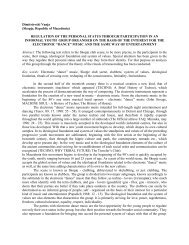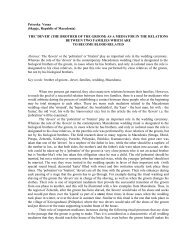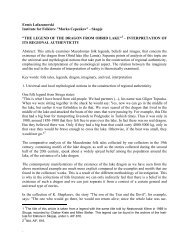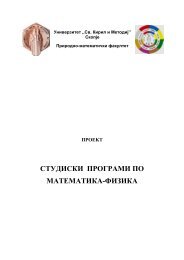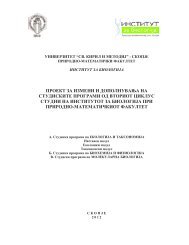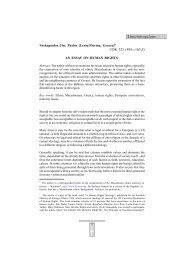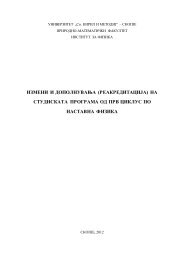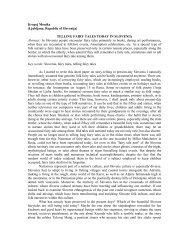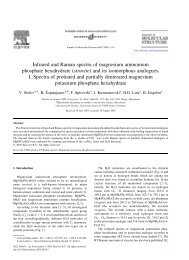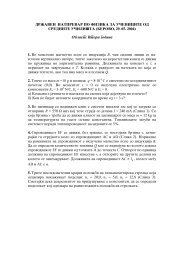Ljupco Nedelkov (Skopje, Macedonia) THE BIRTH RITUAL OF ...
Ljupco Nedelkov (Skopje, Macedonia) THE BIRTH RITUAL OF ...
Ljupco Nedelkov (Skopje, Macedonia) THE BIRTH RITUAL OF ...
Create successful ePaper yourself
Turn your PDF publications into a flip-book with our unique Google optimized e-Paper software.
The rituals which take place in the newborn's home are spurred by the<br />
anxiousness of the family about the psychological, physical and material life of their new<br />
member. So, for example, the godfather would roll the child on the table with leftovers<br />
three times before he would feed the newborn for the first time (Inf. no. 14). The people<br />
there would chip in with some money - so that the child is rich. The money was collected<br />
in the newborn's hat. The tablecloth was taken and left aside for three days. On the third<br />
day, they would shake the carpet, soak it in water and wring it out, and the water<br />
squeezed out in the process would be used to water a fruitful tree (Inf. no. 19).<br />
Before leaving the house, the participants would wash hands and lob metal coins<br />
in a bowl with consecrated water. This water was then used to wash the newborn to<br />
prevent uroci from being cast on it. This part of the ritual ends the baptizing ritual.<br />
The golema molitva to the leunka is like the baptizing to the newborn. This prayer<br />
shows the public phase in the introduction in the social environment, when the people on<br />
whom rituals were performed appeared in front of the fellow villagers so that the latter<br />
could notice their new status (V. Stojancevic, 1979:167). Namely, the leunka would bathe<br />
on the 40 th day, then she would put on clean clothes and, hand in hand with the<br />
grandmother and grandfather, would go straight to church for the golema molitva.<br />
The moment the priest finished reading the prayer for the good health of the<br />
rodilka, she was religiously accepted by religion in the religiously pure community. The<br />
golema molitva marks the end of her marginal status and the transition to the ritually<br />
pure women.<br />
The ritual visits paid to the homes of neighbors and relatives on the way back<br />
from church confirmed the acceptance of the new status of the rodilka and the newborn.<br />
So, for example, after returning from church, the mother and the child first had to visit<br />
another house. The housewives of that house would give to the baby some sugar, flour<br />
and eggs: sugar - so that the child is sweet; flour - so that the child is not hungry and an<br />
egg so that the child's diapers stay clean. The housewives placed these gifts in the baby's<br />
diapers. They had to be used for food. The tour ended when she visited her parent's home<br />
with her child, where she would stay for a week (Inf. no. 11).<br />
According to the rules for what was suggested, on the 40 th day of the birth of the<br />
child the rodilka and the newborn would welcome female members of the broader<br />
community for the first time in public. Then they were given presents (socks, shirts) and<br />
food products (ritual food). The newborn was also given money. After this question the<br />
informants would say: "Mu pustat pari i vikat! Da si kupis bratce-sestrice" (They give<br />
him money and shout! Buy yourself a brother or sister) (Inf. no. 22). The povojnica was<br />
supposed to be brought in the morning, and according to the homeopathic magic principle<br />
(similar=similar), the child was expected to grow as the day grew.<br />
In that sense, the ritual povojnica clearly showed that the community had<br />
symbolically accepted the newborn. In fact, the povojcica implies that the individual has<br />
not yet been introduced in the community, which stressed his marginal position as a<br />
hindrance for his socialization and a precondition for a successful human communication<br />
(P. Vlahovic, 1995:77).<br />
Bibliography:<br />
1. J.Cazeneuve, Socijologija obreda, Ljubljana, 1986.




